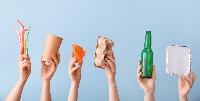Recycling in Canada, just like anywhere, is complicated.
With so many different types of materials and recycling laws that from vary city-to-city and province-to-province, what can be recycled is not always clear.
Here’s a quick guide on what you can and can not recycle in Canada, why Canada’s recycling problem is so complex, and how you can become better at recycling.
Why is Canada so lousy at recycling?
 Jasmin Sessler
Jasmin Sessler
Many Canadians use their blue and green bins regularly, religiously returning plastic and glass bottles to recycling depots or setting bins out on the curb for weekly collection. My family certainly did this when I was growing up. However, Canada has a major recycling problem.
Did you know that Canadians only recycle 9% of the plastics they consume?!
There are a variety of contributing factors...
For one thing, many Canadians do not understand which plastics can and can not be recycled. If people realized how few plastic materials can be recycled, they might factor packaging into their purchase decisions.
Another reason is that in order to be recycled, an item must be clean. This is especially true of containers that once held food. For example, if a plastic peanut butter tub is about to be recycled, it needs to be thoroughly washed first. If not, that one plastic vessel has the potential to contaminate huge amounts of plastic that have been cleaned by other people—and all those plastics will then end up in a landfill rather than actually being recycled.
Additionally, Canada’s low recycling rate can be attributed to plastic waste "from offices, institutions or industries." Large companies and institutions are less likely to adequately wash plastics while mixing non-recyclable items into recycling bins.
Canada's (not-so-little) dirty recycling secret
 Vivianne Lemay
Vivianne Lemay
For many years, Canada was one of many countries shipping recyclables to China and other Asian countries. This export method of disposal is cheap and the Global South often supports a market for recyclables. However, the refuse Canada was shipping abroad was criticized for improper sorting: paper mixed with plastics (which is almost impossible to separate and recycle), plastics contaminated with food scraps, and actual garbage mingling among the recyclables.
In 2018 China declared it would no longer tolerate paper mixed with plastic and the nation certainly wouldn’t accept leftover foods (which should be composted anyway). China now requires 99.5% purity and exports that fall short of this figure are shipped back to the source country.*
How can Canadians citizens help improve the national recycling problem? First and foremost is reducing plastic consumption and reusing items before relying on recycling. We also need to diligently clean recyclables and be mindful of what is and isn’t recyclable in the first place.
What can not easily be recycled in Canada?
It’s difficult to say what can and can not be recycled nation-wide in a single breath because provinces and even municipalities differ in their recycling regulations and infrastructure. So, let’s start with the items that are more difficult to or can not be recycled.
- Each province has different regulations on whether or not lightweight, film plastics (like grocery and produce bags) can be recycled.
- Provinces also vary on if and how batteries and electronics are recycled.
- Foil chip bags and candy wrappers usually can not be recycled, but again, it depends on your municipality’s list of accepted items.
- Pizza boxes are not typically recyclable because they are often contaminated with food waste.
What can be recycled in Canada?
 Josh McLean
Josh McLean
The main things you can recycle in Canada are glass, aluminum, paper, cardboard and some plastics.
Each province maintains its own rules as to what kinds of plastics are accepted, as well as if and what kind of electronics can be recycled. Some provinces also accept the recycling of materials such as paint, tires and even oil.
Here is a list of government websites for each province and territory so you can find out what can be recycled where you live:
What can be recycled in the Yukon
What can be recycled in the Northwest Territories
What can be recycled in Nunavut
What can be recycled in British Columbia
What can be recycled in Alberta
What can be recycled in Saskatchewan
What can be recycled in Manitoba
What can be recycled in Ontario
What can be recycled in Quebec
What can be recycled in Newfoundland
What can be recycled in New Brunswick
What can be recycled in Nova Scotia
What can be recycled in Prince Edward Island
Recycling initiatives that accept difficult-to-recycle items
There are two amazing recycling initiatives that I know of in Canada which operate independently of government-controlled recycling programs.

The first one is Terracycle. Terracycle is famous for accepting items that are normally very difficult to recycle. You can get Terracycle boxes installed in your home, office or school. They allow you to recycle notoriously difficult to recycle items such as coffee capsules, pens and even plastic gloves.
The other really cool recycling initiative that is available in Canada is Green Circle Salons. I used to work at an organic and low-waste hair salon called NJ’s Organic Hair Salon in Kelowna, BC, which is where I learned about Green Circle Salons.
Any hair salon can affiliate with Green Circle Salons, a network which helps hair salons recycle tubes of chemical hair dyes, used foils and more. In fact, Green Circle even recycles the hair that gets swept up at the salon. The hair then gets sent to a facility in Ontario where it is made into booms, which are then used to help soak up oil in the case of oil spills in the ocean.
How to become better at recycling
 Pixel-shotFirst step: reduce and reuse
Pixel-shotFirst step: reduce and reuse
So how can you become a better recycler in Canada? Remember to try and reduce and reuse items before relying on recycling. Glass is infinitely recyclable, but plastic breaks down a little bit every time it is repurposed. That’s why it’s a great idea to choose glass packaged items or paper-packaged items (which can be composted) over plastic-packaged items. Aluminum is more easily recyclable, too.
Another way to reduce and reuse prior to recycling is to practice zero-waste shopping. (Shopping in bulk or at farm markets, bringing your own containers, reusable tote and produce bags, etc.) This is especially effective for cutting down on the plastic that envelopes grocery staples like fruit and vegetables, as well as with things like bakery items, spices and eggs.
Only recycle clean items
When you’re filling up your recycling bins, make sure you clean every item so it’s spotless. Remember, any packaging that has food waste on/in it will contaminate the other materials it comes into contact with on its way to the recycling facility.
Correctly sort recyclables
Remember to separate your plastics from your glass and your cardboard, etc. Mixed items in recycling can also get things unintentionally sent to landfill.
Champion better recycling systems in the workplace and at school
If your school or office deals with waste that is difficult to recycle, talk to management about options like Terracycle and Green Circle Salons.

PS: Ever consider your laundry waste?
Did you know that annually more than 750 million plastic laundry jugs end up in our landfills? Tru Earth has the solution.



